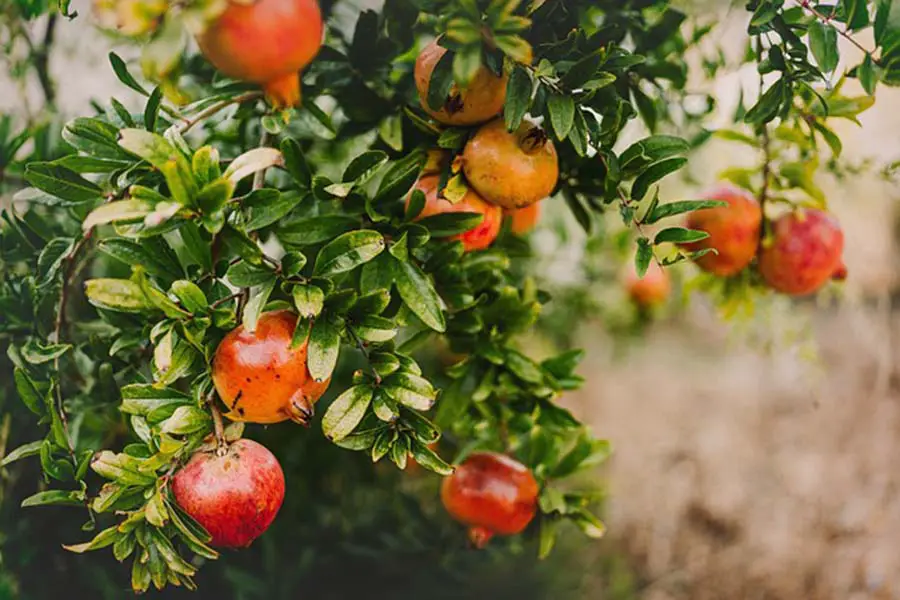
We may receive commissions from purchases made through links in this post, at no additional cost to you.
When you go to buy a pomegranate tree, the number of varieties available can be overwhelming. And the descriptions on plant tags and nursery websites are incomplete, at best. So how do you go about deciding which pomegranate cultivars to plant?
For the best chance at success, choose a pomegranate variety that corresponds to your climate and growing situation. Pomegranate cultivars range in size, color, flavor, hardiness, and harvest time. Some of the most popular varieties to grow include ‘Parfianka,’ ‘Wonderful,’ and ‘Desertnyi.’
In this article, I’ve sifted through the abundance of options and come up with a helpful list of the best pomegranate varieties to grow at home – including details of what makes each variety special. Before digging into the tastiest, hardiest, biggest, sweetest, and most reliable cultivars, let’s look at how to narrow down the pomegranate choices for each growing situation.
How to Choose the Right Pomegranate Tree
There are over 500 known pomegranate cultivars throughout the world. Most pomegranate trees grow in USDA zones 7-10, but some can be pushed into zone 6 with care (see the list of cold-tolerant varieties below).
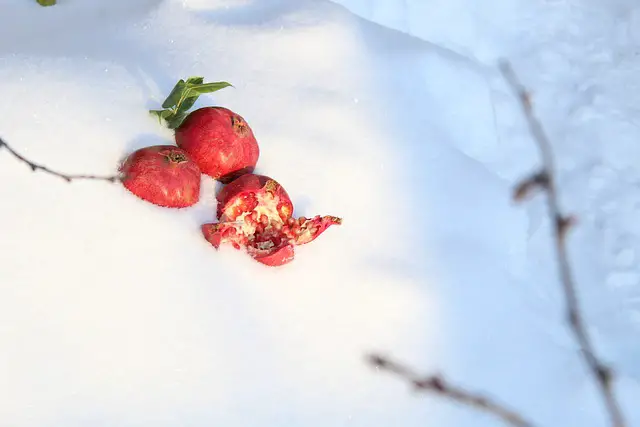
There are pomegranates for every taste and climate. The fruits range in size from about 2-6 inches in diameter, and they have colorful, leathery skin. Inside are edible, juicy, brightly-colored arils that range in flavor from very sweet to strongly acidic.
When choosing which pomegranate varieties to plant, consider:
Climate
Pomegranates, thankfully, can grow well in a wide range of climates and soil types. The ideal location has hot, dry summers and cool winters (Mediterranean climate), and well-drained soil that is slightly acidic to neutral (5.5 – 7.0 pH). Each fruit takes 6 to 7 months to mature and is typically harvested in fall.
Learn more: Picking Perfect Pomegranates: How to Know It’s Harvest Time
Pomegranate trees thrive in the heat – most varieties grow best where there are at least 120 days of 85°F or higher temperatures. But if you live in an area with mild summers, don’t despair. Some varieties, such as ‘Desertnyi’, do well in temperate climates without the high summer heat.
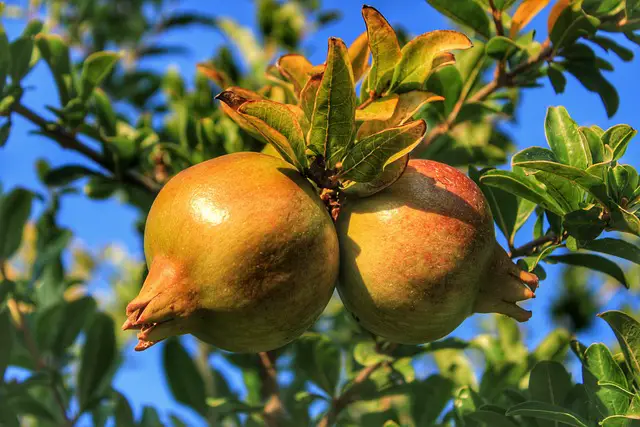
It’s speculated that varieties with higher acidity (like the ever-popular ‘Wonderful’) do better in high-heat areas. The intensity of the sun reduces acidity and increases sugar content. Varieties that have more natural sweetness and less acidity can get away with less heat.
Cold-Hardiness
Many pomegranate trees are hardy to zone 7b or 8 (10°F), but some are more sensitive to frosts around 18°F. Luckily, pomegranates blossom mid- to late-spring, so they are less prone to frost damage than some other earlier-flowering fruit trees (like apricots).
It’s possible to grow a pomegranate tree in zone 6 or 7 by planting it in a warmer microclimate in your yard. For example, plant near a fence or wall to take advantage of reflected heat. Avoid low-lying areas where frost tends to settle, and choose a location that’s sheltered from strong wind. Pomegranate trees can also grow in pots, which can be moved indoors over the winter.
Related: Where to Plant a Pomegranate Tree
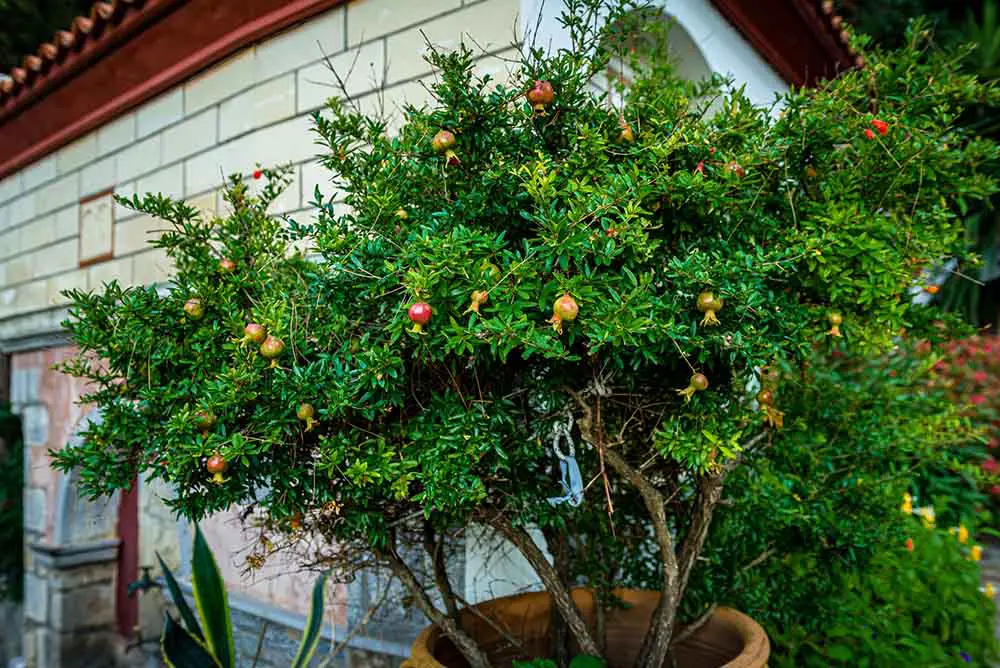
Size
Pomegranate trees range in size from 3 feet to 30 feet, but most grow to be 8-15 feet tall. It’s relatively easy to control the size of a pomegranate tree with regular pruning, but most do grow vigorously. If you have limited space, choose a variety that naturally stays a bit smaller, such as ‘Parfianka’ or ‘Red Silk’.
Learn more: How Big Will a Pomegranate Tree Grow?
Speaking of size, the fruits themselves can be just a couple of inches across, or up to two pounds. If you are interested in growing larger pomegranates, check out the “Biggest Pomegranates” section below.
Disease Resistance
Although they are drought-tolerant plants, pomegranate trees need consistent soil moisture during the fruiting season. They love the heat, but they can be prone to fungal diseases if the weather is excessively rainy or humid.
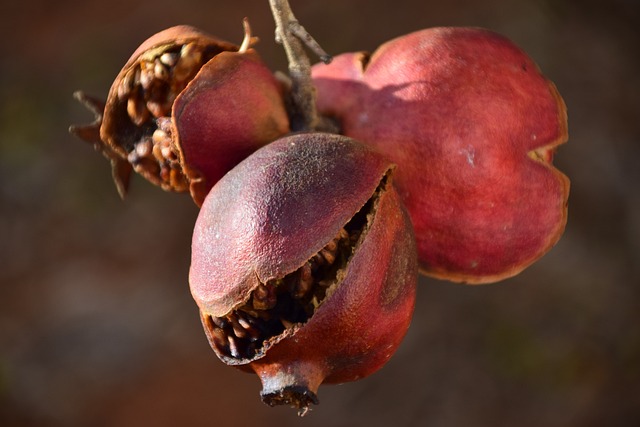
Pomegranates are disease-resistant in general, but some varieties (like ‘Red Silk’ or ‘Russian 26’) are more tolerant of humidity. Certain cultivars, such as ‘Wonderful’ are also resistant to fruit cracking (the plague of pomegranate growers).
Related: Split Pomegranates? Why Splitting Happens and How to Stop It
Taste
The characteristic “pomegranate” flavor is sweet but tart, and sometimes pleasantly astringent. But different cultivars have different flavor profiles, from sweet and fruity, to sharply acidic, and everywhere in between.
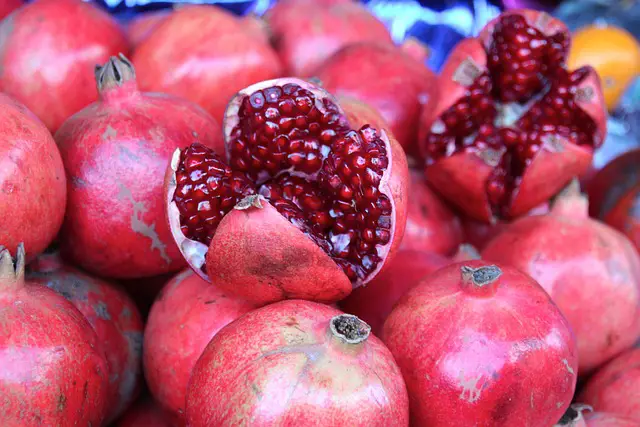
While sweetness is certainly appealing, it’s worth noting that what gives pomegranates their characteristic flavor is acidity. Some of the sweetest pomegranates with the highest Brix (a measurement of sugars and other compounds) taste mild and a little boring next to a typical sweet-tart pomegranate (even if the sugar level is the same or lower).
Whether you like your pomegranates sugary sweet like fruit punch, or with a balance of sweetness and acidity, there is a pomegranate variety for every taste.
Color
Pomegranates can be almost any color, including dark purple, red, bright pink, orange, peach, yellow-gold, almost white, and even green. Even the arils come in a range of colors, from black-red to pink to peachy-clear.
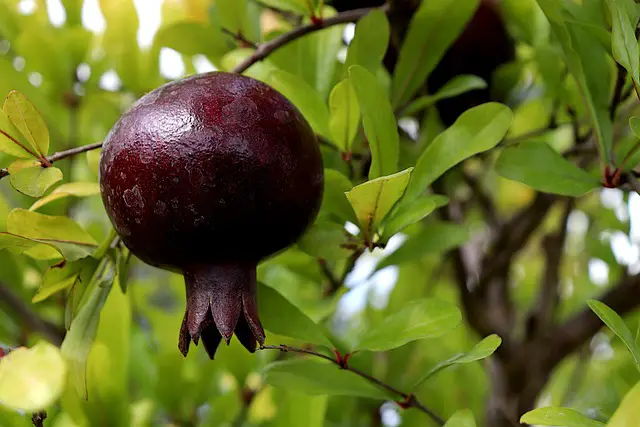
The flowers are highly ornamental and attractive to pollinators, including hummingbirds. They are typically red-orange and tubular, although some varieties have yellow, white, or variegated blossoms.
10 of the Best-Tasting Pomegranate Varieties
Below is a list of 10 of the best all-around pomegranate cultivars to grow at home (according to my own experience, that of other growers, and a ton of research). I’ve tried to make this as helpful as possible by including information about growing, harvesting, flavor, color, and other useful characteristics. I’ve also prioritized varieties that are readily available, although I’ve included a couple that are a little harder to find (but worth it!).
1. ‘Desertnyi’
- Tree size: 10-15 feet
- Fruit color: Orange-red
- Growing zone: 7-10
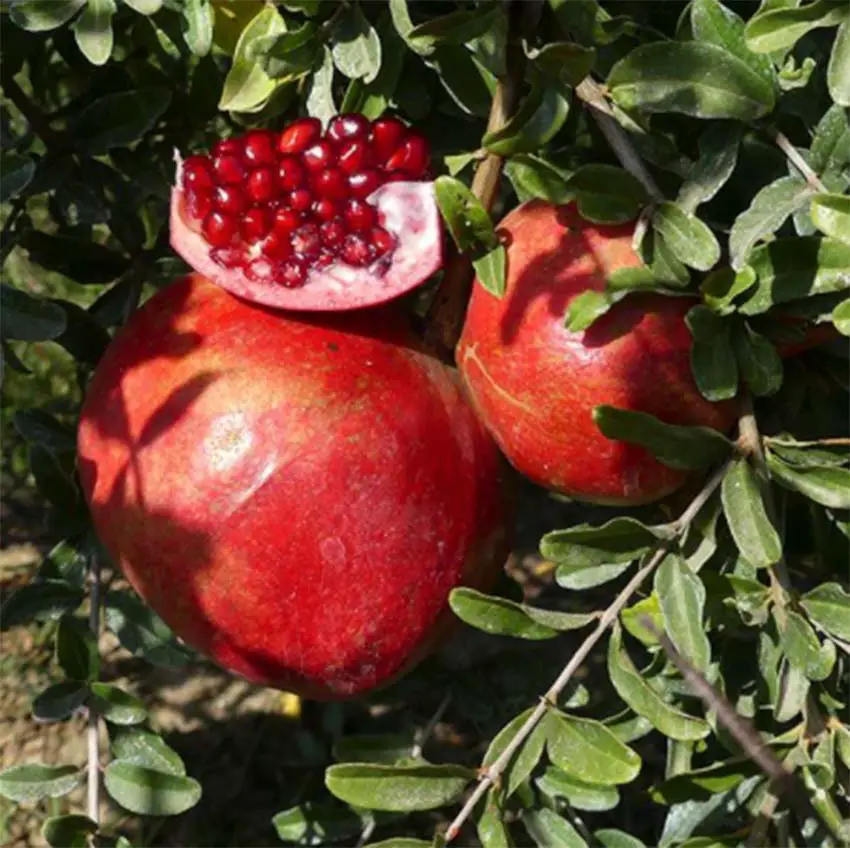
‘Desertnyi’ is one of many pomegranate varieties from Turkmenistan that was rescued and preserved during the fall of the Soviet Union. It grows medium-to-large fruit with peachy red skin and juicy, bright red arils.
The flavor of ‘Desertnyi’ is sweet and citrusy but with enough acidity to still taste like a pomegranate. This tree grows well in areas with mild or hot summer temperatures, and it tolerates some shade. Late fall harvest.
2. ‘Ariana’
- Tree size: 8-10 feet
- Fruit color: Bright red
- Growing zone: 7-10
‘Ariana’ is another good option for limited growing space. It is a great producer of medium to large, bright red pomegranates with dark red arils.
The flavor of ‘Ariana’ pomegranates is rich, somewhat tart, but still sweet. It has very tiny, soft seeds that are perfect for fresh eating. Late harvest.
3. ‘Wonderful’
- Tree size: 10-15 feet
- Fruit color: Deep red
- Growing zone: 8-11
‘Wonderful’ is the quintessential pomegranate – large and bright red, with deep red, juicy arils that have a pleasantly tart-sweet flavor. If you see a pomegranate in a grocery store, it’s probably ‘Wonderful’. It’s by far the most common pomegranate for commercial production, especially in the U.S.
Even though it’s a common variety, I grow ‘Wonderful’ myself because home-grown pomegranates taste vastly superior to store-bought. The shrub can grow quite large (10-15 feet or more) but is easy to keep in check with pruning. It’s highly ornamental, with tons of bright red blooms. ‘Wonderful’ is also resistant to cracking late in the season (one of the reasons it’s popular for growers). Late season harvest.
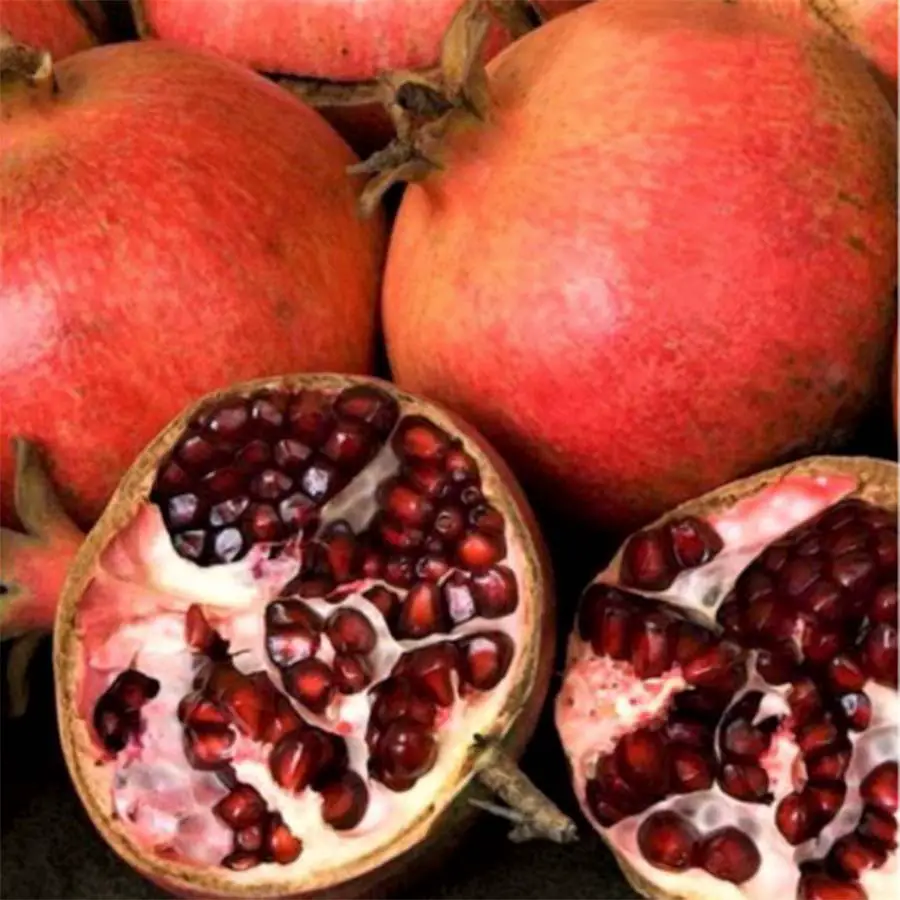
Note – ‘Granada’ is a bud mutation of ‘Wonderful’ with very similar characteristics, but it fruits a few weeks earlier (August – September).
4. ‘Angel Red’
- Tree size: 8-10 feet
- Fruit color: Bright red
- Growing zone: 7-10
This is a good option for growing in containers. ‘Angel Red’ produces a heavy crop of bright red, medium-sized fruits with very juicy, red arils that have soft seeds. The flavor is sweet but with a good bit of tartness.
‘Angel Red’ may fruit in the first year or two after planting, a little sooner than some varieties. It has showy orange/red blossoms in the spring, and the fruits are ripe in the late fall. ‘Ariana’ naturally only grows to about 8-10 feet.
5. ‘Parfianka’
- Tree size: 10 feet
- Fruit color: Bright red with hints of yellow
- Growing zone: 7-10
This pomegranate tree is a natural dwarf that is very productive for its size. ‘Parfianka’ is fast-growing and has large, bright red-yellow fruits. The arils are very dark red (almost black), large, very juicy, with soft seeds.
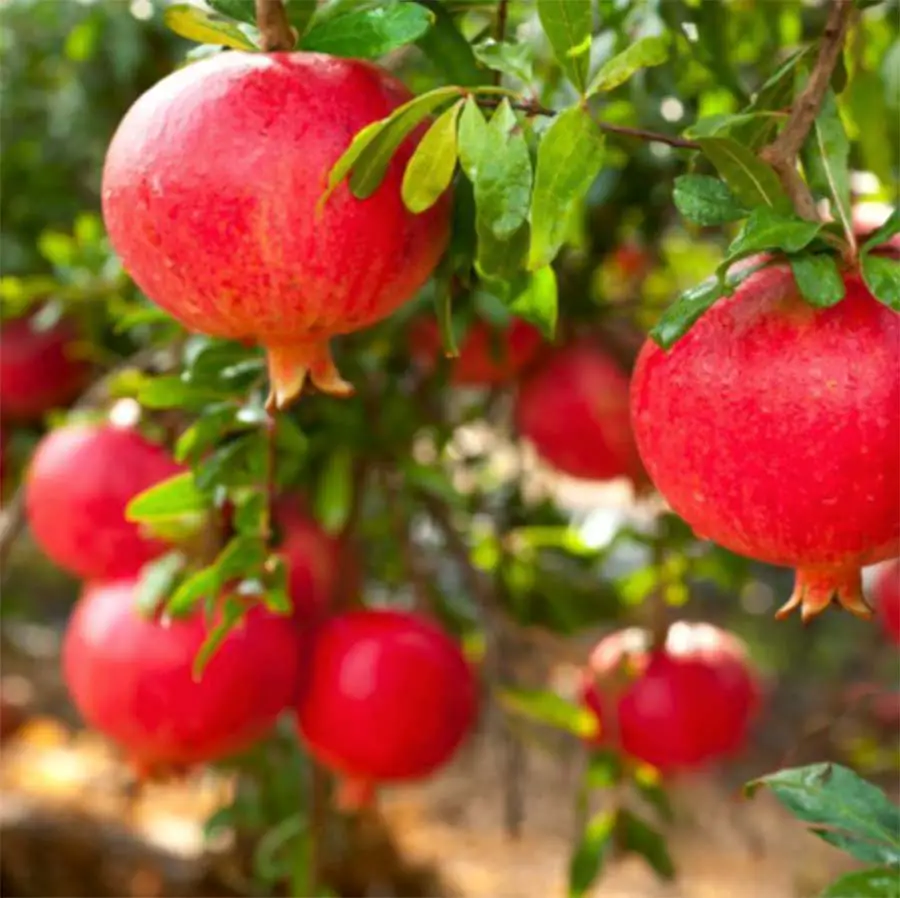
‘Parfianka’ is one of the best-tasting pomegranates you can grow. It’s more sweet than tart, but it has enough acidity to balance the sweetness. Mid-fall harvest.
6. ‘Golden Globe’
- Tree size: 10-12 feet
- Fruit color: Yellow with red blush
- Growing zone: 8-11
‘Golden Globe’ can be a little hard to find, but its unique fruit makes it worth it. The fruit is golden yellow with a slight red blush and peachy pink arils. It’s one of the largest pomegranates you can grow, with fruits reaching 1-2 pounds. It’s sweet juicy, and matures early. ‘Golden Globe’ is a good option for areas with mild summer temperatures.
7. ‘Purple Heart’
- Tree size: 12-16 feet
- Fruit color: Red-purple
- Growing zone: 7b-10
‘Purple Heart’ (also called ‘Sharp Velvet’) grows fruit with reddish-purple skin and deep red arils. It is sweet with less acid than some varieties, but still has a pleasant tanginess. ‘Purple Heart’ is great for juicing and fresh eating.The tree is very productive and grows in zones 7b-10. Expect to harvest the fruit throughout the fall. ‘Purple Heart’ is a fairly large tree or shrub, reaching 12-16 feet when mature.
8. ‘Ambrosia’
- Tree size: 10-16 feet
- Fruit color: Pink
- Growing zone: 8-10
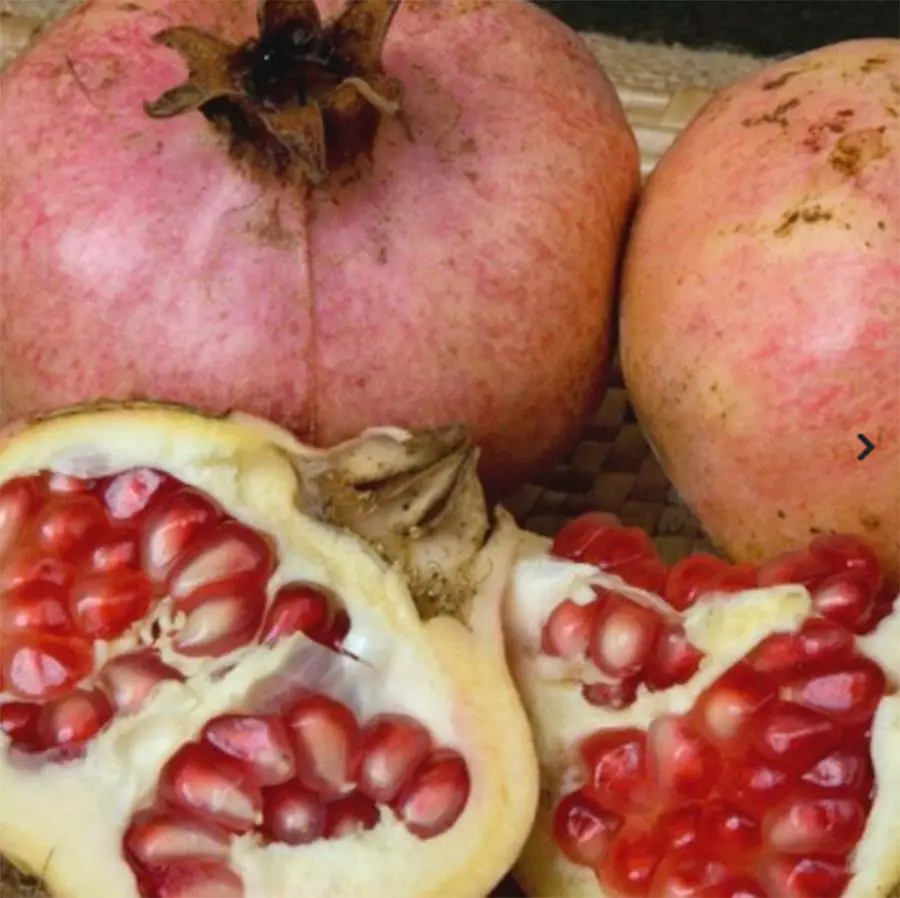
A standout characteristic of ‘Ambrosia’ is its fruit size. ‘Ambrosia’ pomegranate can be gigantic – more than 6 inches in diameter and up to 2 pounds per pomegranate. The tree itself can grow to be 10-16 feet, but could be 20 feet or more if left unpruned.
Ambrosia’s spring blooms are dark orange. Its fruit has peachy pink skin and contrasting purple-red arils, with a taste similar to that of ‘Wonderful’. It’s a long-lived and tough tree that can be grown in zone 8-10. Early-mid fall harvest.
9. ‘Azadi’
- Tree size: 8-12 feet
- Fruit color: Peach/gold
- Growing zone: 8-10
‘Azadi’ has been a top taste-test winner. It’s very sweet, soft-seeded, with a slight tartness that keeps it tasting like a pomegranate. The skin of the fruit is peachy-yellow, and the arils are an almost translucent light pink and very juicy.
‘Azadi’ translates to “freedom” or “independence” in Persian. It ripens early in the fall, even as early as late July or August in warm climates. It is naturally pest-resistant and has orange/red flowers in spring.
10. ‘Sirenevyi’
- Tree size: 10-12 feet
- Fruit color: Pink/red
- Growing zone: (6b)7-10
‘Sirenevyi’ is very cold hardy and adaptable to many climates, and can even be grown successfully in zone 6 with some winter protection. It ripens in late fall (October or November, typically).
This is one of the most popular pomegranate varieties to grow because of its mildly sweet flavor reminiscent of a watermelon. ‘Sirenevyi’ grows large fruits that have pinkish-red skin and dark fuchsia arils with soft seeds.
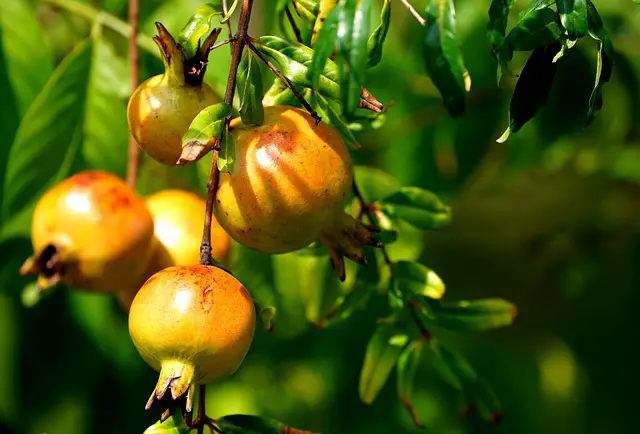
Honorable Mention
Since there are so many delicious, intriguing pomegranate varieties, I couldn’t just leave it at 10. In this section, you’ll find varieties sorted by sweetness, hardiness, and size. Depending on the specifics of your growing situation and preferences, use these lists to narrow down the choices.
Sweetest Pomegranate Varieties
These cultivars are known as some of the sweetest to grow. “Sweetest” doesn’t necessarily mean the highest sugar content, but that the flavor is sweet-dominant. As discussed above, part of the characteristic flavor of pomegranates is a bit of tartness or bite. If you don’t like the hint of astringency, these sweeter varieties might be to your taste.
It’s a good idea to grow more than one pomegranate variety – one with more acidity like ‘Wonderful’ or ‘Angel Red’, and one that’s sweet and mild like those below. Then, when you harvest, remove the arils from the fruit and mix the two types together. Perfect balance!
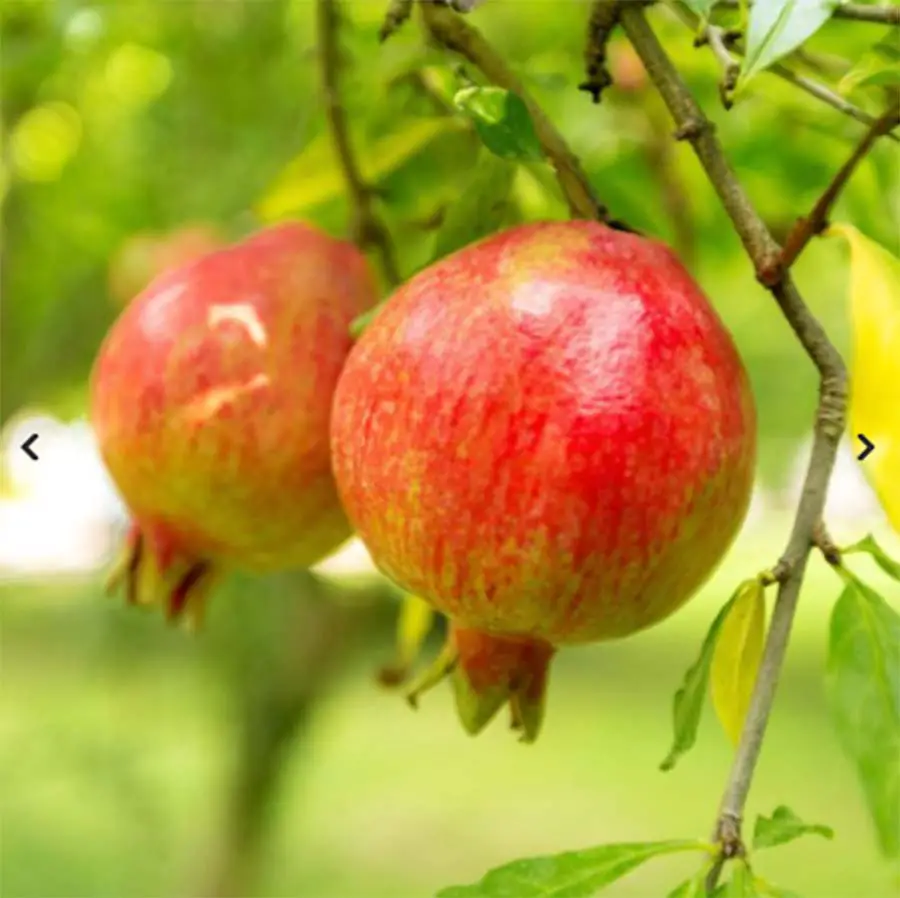
- ‘Sweet’ – ‘Sweet’ pomegranates are pinkish red and, like the name suggests, more sweet than tart. The tree has good resistance to pests and disease and can grow to be 15-18 feet tall. Frost sensitive. Ripens in early fall.
- ‘Utah Sweet’ – This variety grows to be anywhere from 12 to 20 feet or more. It produces tons of pinkish-orange fruits with very sweet pink arils and soft seeds.
- ‘Eversweet’ – This shrub naturally stays a little smaller, between 8 and 10 feet when fully grown. Its orange-red fruits with dark pink arils are very sweet with low acidity. Harvest in mid-fall.
- ‘Pink Satin’ (‘Sin Pepe’, ‘Pink Ice’) – Sin pepe means “seedless” in Italian, which is ironic because seeds are the edible part of a pomegranate. But the seeds are soft, small, and the juice is very sweet and mild, almost like a fruit punch. ‘Pink Satin’ grows medium dark pink-red fruit with light pink arils that are good eaten fresh or juiced.
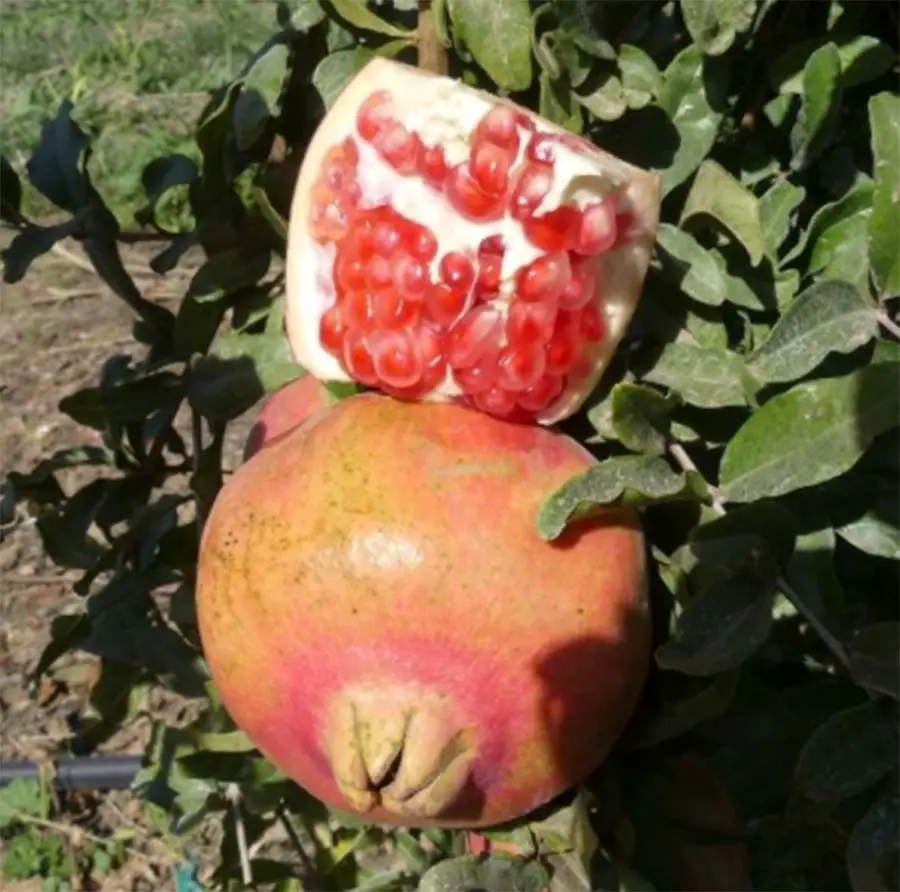
- ‘Desertnyi’ – See description above. This is a very sweet variety, but it still has the characteristic tartness of a pomegranate.
Most Cold-Hardy Pomegranate Varieties
Most pomegranate cultivars grow easily in hardiness zones 8-11 (down to about 10°F), but some are suited to zone 7 (5°F), or can even be pushed into zone 6! The following varieties are some of the most cold-tolerant you can grow.
Even cold-hardy pomegranates are susceptible to late frosts. Once the tree blooms in spring, its blossoms and young fruit can be damaged or killed by a sudden cold snap. Pomegranate trees are much hardier when they are fully dormant.
Protect pomegranate trees during the winter by mulching heavily with shredded leaves, pine bark, or compost (leave several inches free around the trunk). Or, plant the tree in a container and bring it indoors during the coldest part of the season.
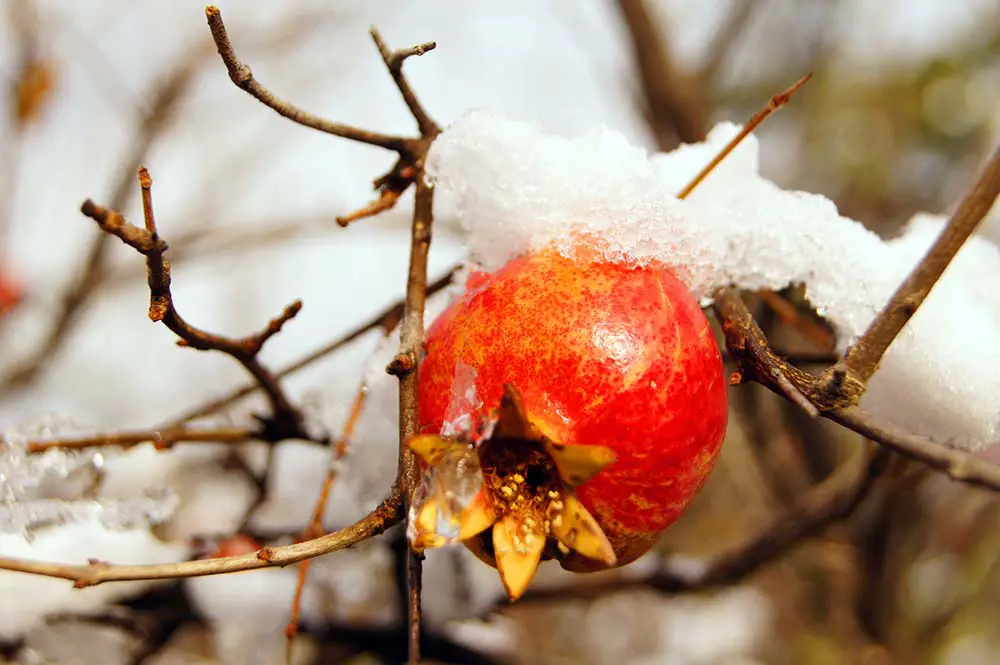
- ‘Salavatski’ (‘Russian Red’) – This is a very cold-hardy pomegranate that has been known to grow and fruit as far north as USDA zone 6. It has large fruit with orange-red skin and deep red arils (be warned – the seeds are crunchy).
- ‘Russian 26’ – ‘Russian 26’ is very cold-hardy, especially if grown near a south-facing wall or fence. It’s a heavy producer of large red fruit with decent flavor. Not only is it cold-tolerant and frost-resistant, but it also does well with heat and humidity. 8-10 feet tall.
- ‘Medovyi Vasha’ – This is probably the best-tasting of the cold-hardy varieties. It can withstand temperatures as low as 5°F (perhaps lower with some protection) and still produce a reliable crop. It ripens early in the fall, making it a good choice for areas with a short growing season. The fruits are medium-to-large, pink-red, with soft seeds and a mild, honey-sweet flavor (it translates to “your honey” in Ukrainian).
Biggest Pomegranates
Sometimes you just want to grow the largest possible fruit. These are some of the biggest pomegranates you can grow (find details in the “10 Best” section above):
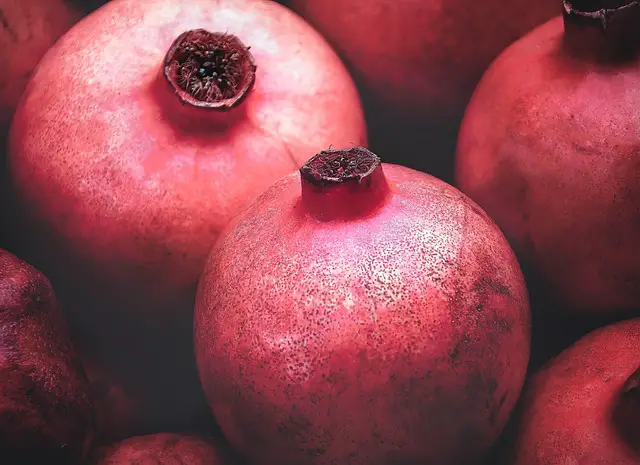
- ‘Ambrosia’ – See description here.
- ‘Golden Globe’ – See description here.
- ‘Wonderful’ – See description here.
Best Pomegranates for Container Growing
These are the most petite pomegranate trees. You can grow just about any pomegranate variety in a pot (as long as it’s big enough), but the following cultivars will stay naturally smaller:
- ‘Red Silk’ – This is a natural dwarf pomegranate tree that will grow up to 6 feet tall and can tolerate a lot of pruning. ‘Red Silk’ produces medium-sized fruit with red skin and gold arils. It has a mellow flavor that is mildly sweet with a bit of acidity. Tolerates heat and humidity well.
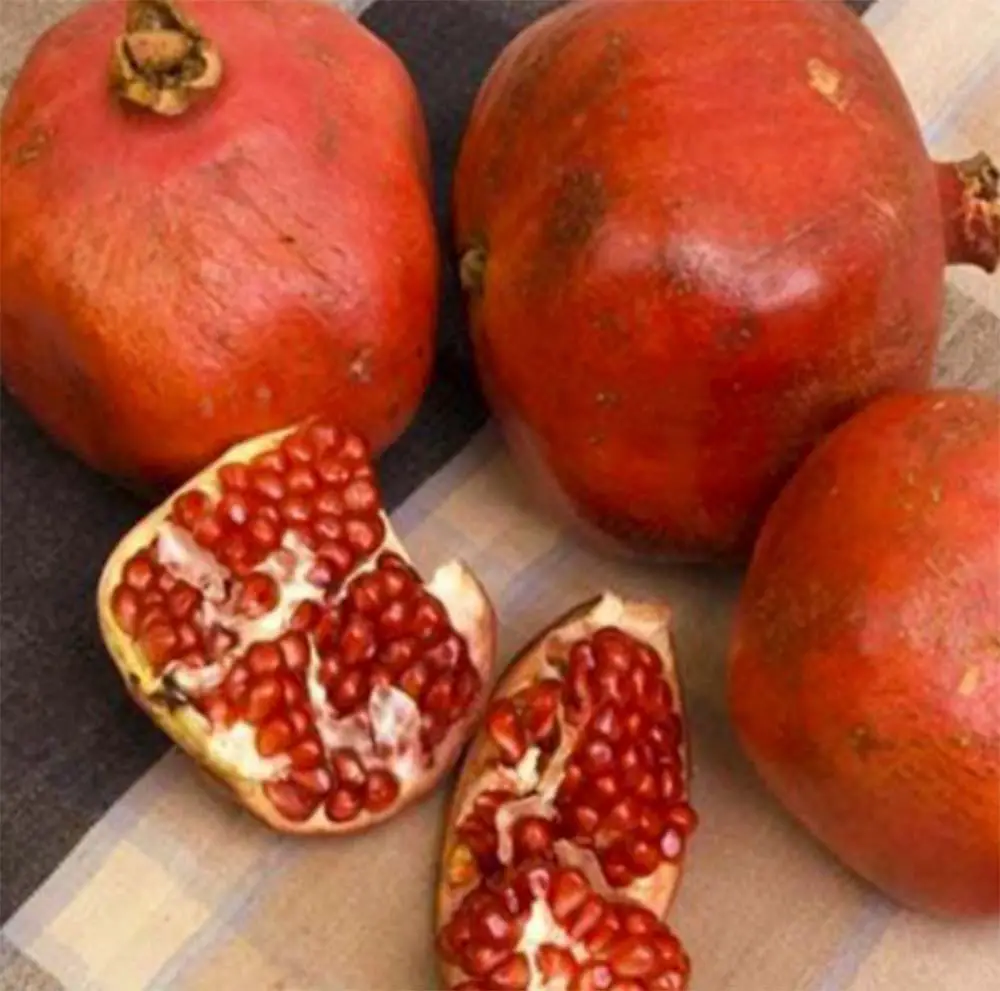
- ‘Texas Pink’ – ‘Texas Pink’ grows very juicy dark pink fruit with a sweet and tangy flavor. It’s resistant to cold (may work for zone 7) and is easy to keep compact with yearly pruning.
- ‘Nana’ (‘Dwarf Red’) – ‘Nana’ naturally stays under four feet tall, and is often maintained at 2 – 3 feet tall as a bonsai tree. It does grow beautiful deep red, 2-inch pomegranates, but the flavor is somewhat tart. ‘Nana’ is typically grown as an ornamental plant for its prolific red flowers and tiny jewel-like fruit.
- ‘Angel Red’ – See description here.

